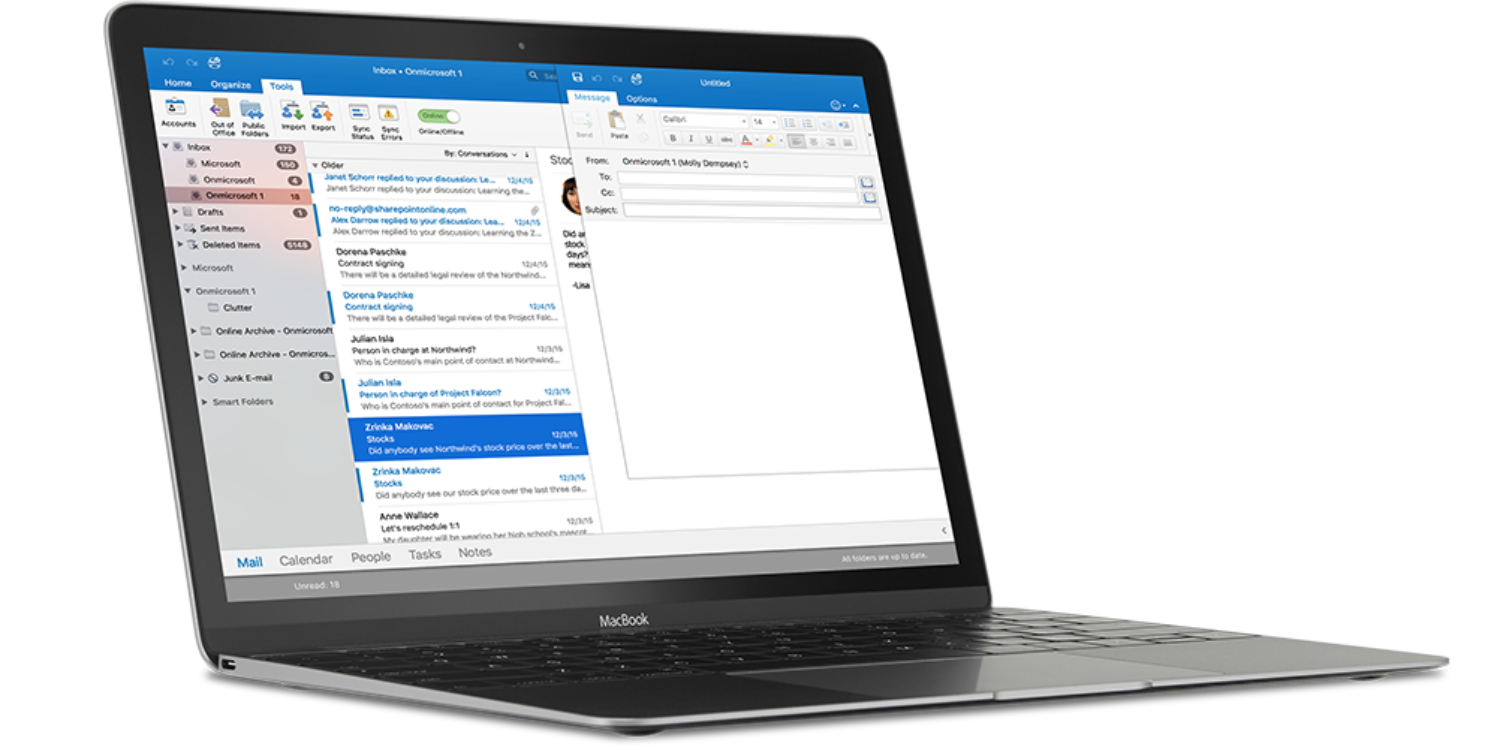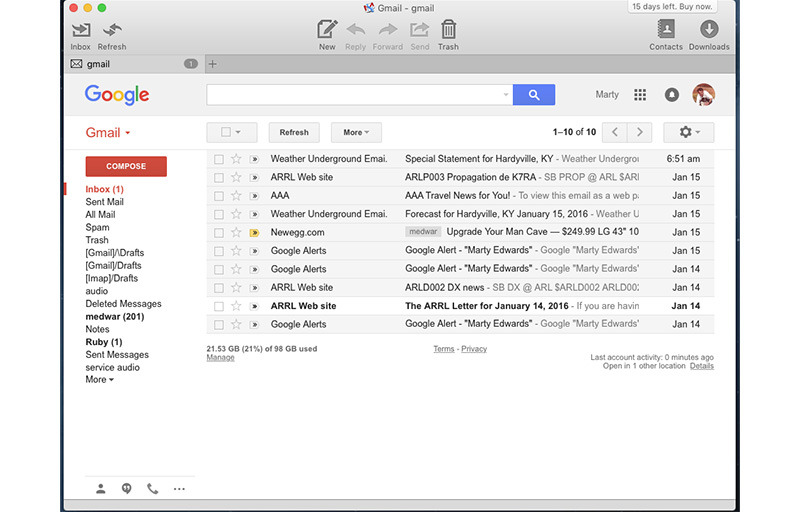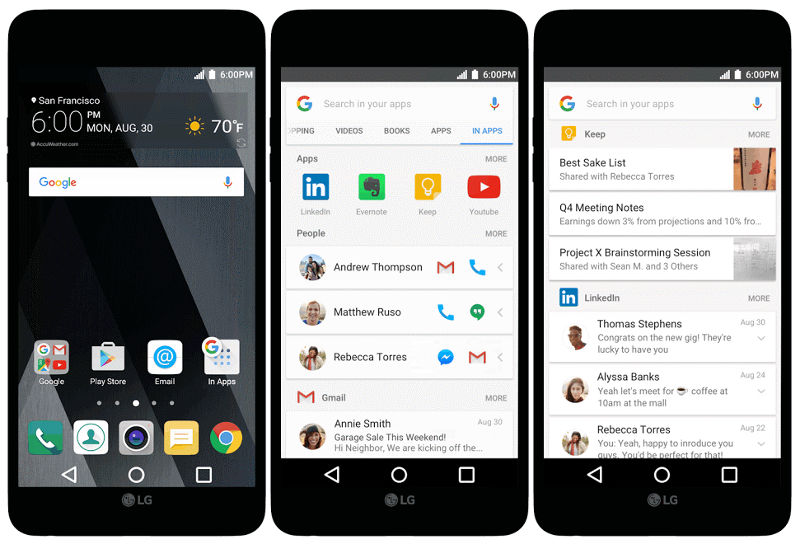- Desktop App For Gmail On Macos Catalina
- Desktop App For Gmail On Macos Mac
- Desktop App For Gmail On Macos Windows 10
- Does Gmail Have A Desktop App For Mac
- Desktop App For Gmail On Macos High Sierra
- Requirements
- Create a new project
- Create and run
- Distribution
- macOS-specific support
- Entitlements and the App Sandbox
- Plugin support
- Desktop support allows you to compile Flutter source code to a native Windows, macOS, or Linux desktop app. Flutter’s desktop support also extends to plugins—you can install existing plugins that support the macOS or Linux platforms, or you can create your own.
- Go for Gmail Install Go for Gmail if you want to check Gmail from your Mac's menu bar. You can click on the menu bar icon to toggle the app window, which lays out Gmail exactly as it appears online. You'll also find a few additions, such as a full screen toolbar button and a mode-switcher button.
- Download Mail for Gmail for macOS 10.11 or later and enjoy it on your Mac. Enjoy all the advantages of accessing your Gmail account, separate from your browser: - Quickly access Gmail from the menu bar - Badge dock icon with unread email counter - Receive and customize unread email notifications - Touch Bar support - Compact mode.
- For most (if not all) of Google's free Products (e.g., Gmail, YouTube, Hangouts, etc.), Google doesn't provide a direct way to contact them from a phone, email or chat without being a 1 Google One (One) customer.
Your desktop anywhere. Securely access your computer from your phone, tablet, or another computer. It's fast, simple, and free. Chrome Remote Desktop.
Desktop support allows you to compile Flutter source codeto a native Windows, macOS, or Linux desktop app. Flutter’s desktopsupport also extends to plugins—you can install existing plugins that support the macOS or Linux platforms,or you can create your own.
Warning:Alpha! This page covers desktop support, which is available as alpha-quality features in the Flutter dev channel. Support still has notable feature gaps, including accessibility support.
Note: To compile a desktop app, you must build the app on the targeted platform: build a Windows app on Windows, a macOS app on macOS, and a Linux app on Linux. If you experience a problem that hasn’t yet been reported, please file an issue and include “desktop:macos/linux/windows” (whichever platform is appropriate) in the title.
Requirements
To create a Flutter app with desktop support, you need thefollowing software:
- Flutter SDK. See theFlutter SDK installation instructions.
- Optional: An IDE that supports Flutter.You can install Android Studio, IntelliJ IDEA,or Visual Studio Code andinstall the Flutter and Dart pluginsto enable language support and tools for refactoring,running, debugging, and reloading your desktop appwithin an editor. See setting up an editorfor more details.
Additional Windows requirements
For Windows desktop development,you need the following in addition to the Flutter SDK:
- Visual Studio 2019 (not to be confused with Visual Studio Code)with the “Desktop development with C++” workload installed,including all of its default components
Additional macOS requirements
For macOS desktop development,you need the following in addition to the Flutter SDK:
- CocoaPods if you use plugins
Additional Linux requirements
For Linux desktop development,you need the following in addition to the Flutter SDK:
- libblkid
- liblzma
The easiest way to install the Flutter SDK along with thesedependencies is by using snapd.For more information, see Installing snapd.
Once you have snapd, you can install Flutter using the Snap Store,or at the command line:
If snapd is unavailable on the Linux distro you’re using,you might use the following command:
Create a new project
You can use the following stepsto create a new project with desktop support.
Set up
At the command line, perform the following commands tomake sure that you have the latest desktop support and thatit’s enabled. If you see “flutter: command not found”,then make sure that you have installed theFlutter SDK and that it’s in your path.
Where <platform> is windows, macos, or linux:
To ensure that desktop is installed,list the devices available.You should see something like the following(you’ll see Windows, macOS, or Linux,depending on which platforms you’ve enabled):
You might also run flutter doctor to see if there areany unresolved issues. It should look something likethe following on Windows:
On macOS, you might see something like the following:
On Linux, you might see something like the following:
If flutter doctor finds problems for a platform you don’tsupport, you can ignore those warnings. You don’t haveto install Android Studio and the Android SDK,for example, if you’re writing a Linux desktop app.
After enabling desktop support, restart your IDE.You should now see windows (desktop), macOS (desktop), or linux (desktop) in the device pulldown.
Note: You only need to execute flutter config --enable-<platform>-desktop once. You can always check the status of your configuration using the no-argument flutter config command.
Create and run
Creating a new project with desktop support is no differentthan creating a new Flutter project for other platforms.
Once you’ve configured your environment for desktopsupport, you can create and run a desktop app eitherin the IDE or from the command line.
IDE
After you’ve configured your environment to supportdesktop, make sure you restart the IDE if it wasalready running.
Create a new app in your IDE and it automaticallycreates iOS, Android, and desktop versions of your app.(And web, too, if you’ve enabled web support.)From the device pulldown, select windows (desktop),macOS (desktop), or linux (desktop)and run your app to see it launch on the desktop.
Command line
To create a new app that includes desktop support(in addition to mobile support), run the following commands,substituting myapp with the name of your project:
To launch your app from the command line,enter one of the following commands from the topof the package:

Note: If there aren’t any other connected devices, the -d <platform> tag is optional.
Build a release app
To generate a release build run one of the following commands:
Distribution
Desktop App For Gmail On Macos Catalina
Rio vista elementary school canyon country california lodging. In general, we don’t recommend releasing a desktop app untildesktop support is stable.There are not yet full instructions, or tooling support,for making distributable applications. However,here is some information about how to use the currentbuild output on other machines for testing purposes.
Windows
The executable can be found in your project underbuildwindowsrunner<build mode>.In addition to that executable, you need the following:
- From the same directory:
- all the
.dllfiles - the
datadirectory
- all the
- The Visual C++ redistributables.You can use any of the methods shown in thedeployment example walkthroughs on the Microsoft site.If you use the
application-localoption, you need to copy:msvcp140.dllvcruntime140.dllvcruntime140_1.dll
Place the DLL files in a directory next to the executableand the other DLLs, and bundle them together in a zip file.
macOS

The .app is self-contained, and can be distributed as-is.
Linux
For information on publishing a Linux app to theSnap Store, seeBuild and release a Linux desktop app.
As the tooling solidifies, stay tuned for updates on other waysto distribute a Linux desktop app.
Desktop App For Gmail On Macos Mac
Add desktop support to an existing Flutter app
To add desktop support to an existing Flutter project,run the following command in a terminal from theroot project directory:
This adds the necessary desktop files and directories to yourexisting Flutter project.
macOS-specific support
The following information applies only to macOS development.
Entitlements and the App Sandbox
Desktop App For Gmail On Macos Windows 10
macOS builds are configured by default to be signed,and sandboxed with App Sandbox.This means that if you want to confer specificcapabilities or services on your macOS app,such as the following:
- Accessing the internet
- Capturing movies and images from the built-in camera
- Accessing files
Then you must set up specific entitlements in Xcode.The following section tells you how to do this.
Setting up entitlements
Managing sandbox settings is done in themacos/Runner/*.entitlements files. When editingthese files, you shouldn’t remove the originalRunner-DebugProfile.entitlements exceptions(that support incoming network connections and JIT),as they’re necessary for the debug and profilemodes to function correctly.
If you’re used to managing entitlement files throughthe Xcode capabilities UI, be aware that the capabilitieseditor updates only one of the two files or,in some cases, it creates a whole new entitlementsfile and switches the project to use it for all configurations.Either scenario causes issues. We recommend that youedit the files directly. Unless you have a very specificreason, you should always make identical changes to both files.
If you keep the App Sandbox enabled (which is required if youplan to distribute your app in the App Store), you need to manageentitlements for your application when you add certain pluginsor other native functionality. For instance, using thefile_chooser plugin requires adding either thecom.apple.security.files.user-selected.read-only orcom.apple.security.files.user-selected.read-write entitlement.Another common entitlement is com.apple.security.network.client,which you must add if you make any network requests.
Without the com.apple.security.network.client entitlement,for example, network requests will fail with a message such as:
Important: The com.apple.security.network.server entitlement, which allows incoming network connections, is enabled by default only for debug and profile builds to enable communications between Flutter tools and a running app. If you need to allow incoming network requests in your application, you must add the com.apple.security.network.server entitlement to Runner-Release.entitlements as well, otherwise your app will work correctly for debug or profile testing, but will fail with release builds.
For more information on these topics,see App Sandbox and Entitlementson the Apple Developer site.
Does Gmail Have A Desktop App For Mac
Hardened runtime
If you choose to distribute your application outsideof the App Store, you need to notarize your applicationfor compatibility with macOS 10.15+.This requires enabling the Hardened Runtime option.Once you have enabled it, you need a valid signingcertificate in order to build.
By default, the entitlements file allows JIT for debug builds but,as with App Sandbox, you may need to manage other entitlements.If you have both App Sandbox and Hardened Runtime enabled,you may need to add multiple entitlements for the same resource.For instance, microphone access would require bothcom.apple.security.device.audio-input (for Hardened Runtime)and com.apple.security.device.microphone (for App Sandbox).
For more information on this topic,see Hardened Runtime on the Apple Developer site.
Plugin support
Flutter on the desktop supports using and creating plugins.
Using a plugin
To use a plugin that supports desktop,follow the steps for plugins in using packages.Flutter automatically adds the necessary native codeto your project, as with iOS or Android.
Desktop App For Gmail On Macos High Sierra
We recommend the following plugins, which have beenupdated to work for desktop apps:

Use the following links to find all packages on pub.devthat support desktop apps. These links lists all packages,not just plugin packages. (Remember that plugin packages,or plugins, provide an interface to platform-specific services.)
Writing a plugin
When you start building your own plugins,you’ll want to keep federation in mind.Federation is the ability to define several different packages,each targeted at a different set of platforms,brought together into a single plugin for ease of use by developers.For example, the Windows implementation of the url_launcher is reallyurl_launcher_windows, but a Flutter developer can simply add theurl_launcher package to their pubspec.yaml as a dependency and thebuild process pulls in the correct implementation based on the target platform.Federation is handy because different teams with different expertisecan build plugin implementations for different platforms.You can add a new platform implementation to anyendorsed federated plugin on pub.dev, so long as you coordinatethis effort with the original plugin author.
For more information, including information about endorsed plugins,see the following resources:
- Developing packages and plugins, particularly theFederated plugins section.
- How to write a Flutter web plugin, part 2,covers the structure of federated plugins andcontains information applicable to desktopplugins.
- Modern Flutter Plugin Development coversrecent enhancements to Flutter’s plugin support.
Samples and codelabs
- Write a Flutter desktop application
- A codelab that walks you through buildinga desktop app that integrates the GitHubGraphQL API with your Flutter app.
You can run the following samples as desktop apps,as well as download and inspect the source code tolearn more about Flutter desktop support.
- Flutter Gallery running web app, repo
- A samples project hosted on GitHub to help developersevaluate and use Flutter. The Gallery consists of acollection of Material design widgets, behaviors,and vignettes implemented with Flutter.You can clone the project and run Gallery as a desktop appby following the instructions provided in the README.
- Photo Search app
- A sample app built as a desktop application thatuses the following desktop-supported plugins:
